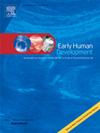The role of prenatal testosterone-estrogen balance in the development of Os trigonum: A comparative matched-pair analysis
IF 2
3区 医学
Q2 OBSTETRICS & GYNECOLOGY
引用次数: 0
Abstract
Background
The 2D:4D ratio, a marker of the prenatal testosterone-estrogen balance, is defined as the proportion of the second to fourth finger lengths, with lower values indicating greater testosterone exposure. Studies demonstrated that this exposure affects chondrocyte activity and function during secondary ossification. Considering that the os trigonum is an unfused secondary ossification center, investigating the relationship between hormonal balance and os trigonum could provide valuable insights as etiopathogenesis.
Aim
To investigate the relationship between the presence of os trigonum and the 2D:4D ratio.
Methods
A matched-pair cohort study was conducted to compare patients with and without an os trigonum among those undergoing ankle arthroscopy between 2019 and 2024. 34 patients in each group were matched 1:1 by age, sex, body mass index, and history of ankle overuse before age 14. Finger lengths were measured with a caliper and 2D:4D ratios were determined.
Results
The analysis revealed that patients with os trigonum had significantly lower 2D:4D ratios in the right hand (p < 0.001), left hand (p < 0.001), and average of both (p < 0.001) compared to those without. The average 2D:4D ratio had the highest predictive ability (AUC = 0.867), with a cut-off of 0.997 predicting the presence of os trigonum with 91.2 % sensitivity and 70.6 % specificity.
Conclusion
A low 2D:4D ratio, indicative of high intrauterine testosterone exposure, is associated with the presence of an os trigonum. Therefore, this research contributes to the growing evidence that prenatal testosterone exposure, may influence specific skeletal characteristics, such as the formation of accessory bones.

产前睾酮-雌激素平衡在三角肌发育中的作用:一项比较配对分析
2D:4D比值是产前睾酮-雌激素平衡的标志,定义为第二指与第四指长度的比例,数值越低表明睾酮暴露程度越高。研究表明,在继发性骨化过程中,这种暴露会影响软骨细胞的活性和功能。考虑到三角肌是一个未融合的继发性骨化中心,研究激素平衡与三角肌的关系可以为其发病机制提供有价值的见解。目的探讨三角肌的存在与二维:四维比值的关系。方法采用配对队列研究,比较2019年至2024年接受踝关节镜检查的患者中有和没有三角肌的患者。每组34例患者按年龄、性别、体重指数、14岁前踝关节过度使用史按1:1匹配。用卡尺测量手指长度,并测定2D:4D比值。结果分析显示,三角区综合征患者右手2D:4D比值明显降低(p <;0.001),左手(p <;0.001),两者的平均值(p <;0.001)。平均2D:4D比值预测能力最高(AUC = 0.867),截止值为0.997,敏感性91.2%,特异性70.6%。结论低2D:4D比值与高宫内睾酮暴露有关,与三角肌的存在有关。因此,这项研究提供了越来越多的证据,证明产前睾酮暴露可能会影响特定的骨骼特征,如副骨的形成。
本文章由计算机程序翻译,如有差异,请以英文原文为准。
求助全文
约1分钟内获得全文
求助全文
来源期刊

Early human development
医学-妇产科学
CiteScore
4.40
自引率
4.00%
发文量
100
审稿时长
46 days
期刊介绍:
Established as an authoritative, highly cited voice on early human development, Early Human Development provides a unique opportunity for researchers and clinicians to bridge the communication gap between disciplines. Creating a forum for the productive exchange of ideas concerning early human growth and development, the journal publishes original research and clinical papers with particular emphasis on the continuum between fetal life and the perinatal period; aspects of postnatal growth influenced by early events; and the safeguarding of the quality of human survival.
The first comprehensive and interdisciplinary journal in this area of growing importance, Early Human Development offers pertinent contributions to the following subject areas:
Fetology; perinatology; pediatrics; growth and development; obstetrics; reproduction and fertility; epidemiology; behavioural sciences; nutrition and metabolism; teratology; neurology; brain biology; developmental psychology and screening.
 求助内容:
求助内容: 应助结果提醒方式:
应助结果提醒方式:


